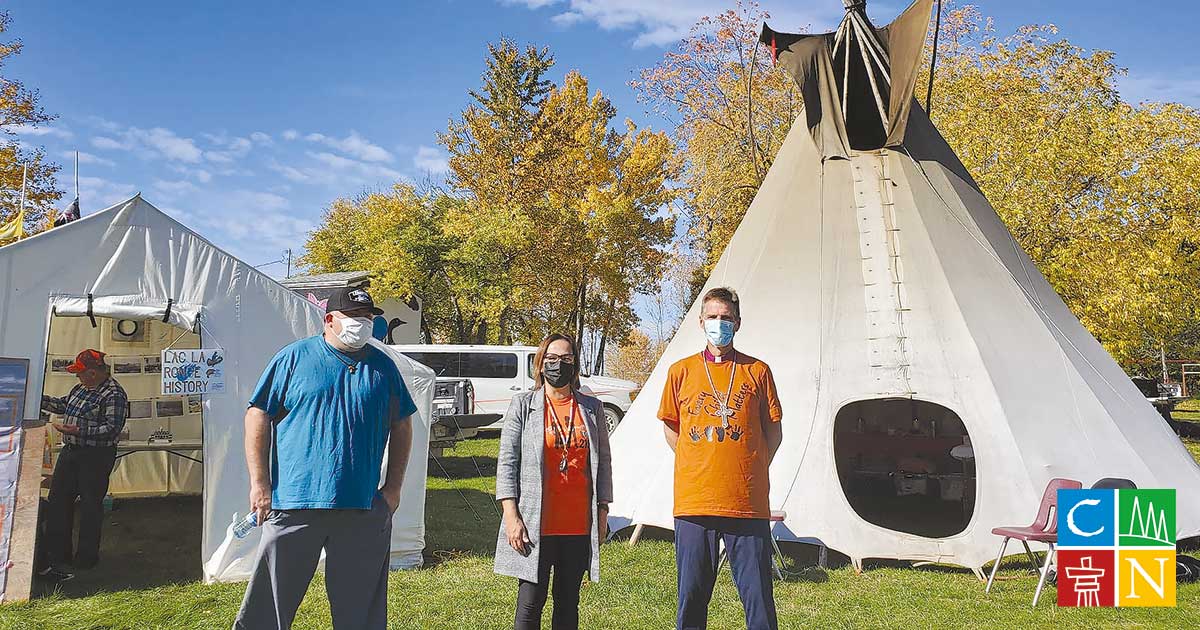By Diana Swift
From the Anglican Journal
Despite its pristine location in Saskatchewan’s boreal forest on the edge of the Canadian Shield, the town of La Ronge, Sask. (population: ca 5,700) has had its share of pain—experiencing, since 2015, a suicide crisis and evacuation for wildfires.
Recently this town, about 250 km north of Prince Albert, has been facing a new cause for grief: the discovery of unmarked graves of Indigenous pupils who died at a local former residential school—this one operated by the Anglican Church of Canada.
The Lac La Ronge Indian Residential School opened in 1907. It burned down in 1920 and was thereafter replaced with a new school, All Saints. According to Indian Affairs records cited in a University of Regina profile of the school, a 1937 government inspector expressed concern
at how poorly the children were being fed. The inspector also described overcrowding of classrooms and dormitories, in which students with tuberculosis slept alongside their classmates. All Saints burned to the ground in 1947 after two boys set it on fire, and its students were then transferred to another school.
On Oct. 1, a day after Canada’s first National Day for Truth and Reconciliation, the diocese of Saskatchewan’s bishop, Michael Hawkins, and diocesan Indigenous bishop Adam Halkett attended a survivors’ gathering in the old cemetery across from All Saints Anglican Church, the town’s oldest building. They joined school survivors and members of the Woodland Cree Lac La Ronge Indian Band (LLRIB) to observe a search for unmarked graves at the site, an initiative which began in July.
Some grave markers for these deceased children (as well as other community members) still exist, but LLRIB chief Tammy Cook-Searson confirmed that a substantial number of unmarked graves had been found.
“We did have to do a lot of cleanup on the site. It was very overgrown,” she said. “The band used to have an elder, an archdeacon, who looked after the site but except for the front part, the cemetery hasn’t been kept up in recent years.” Aiding in the search is a ground-penetrating radar machine supplied by engineering firm SNC Lavalin.
The fourth volume of the report of the Truth and Reconciliation Commission, released in 2016, deals with missing residential school children and unmarked graves. According to the report, government regulations around cemeteries were “non-existent or undeveloped” when many residential schools were founded, so that “most residential school cemeteries were established informally,” with, frequently, a lack of thought given to their continuing care once the schools closed. The commission attempted to document former residential school cemeteries but found that most were “abandoned, disused, and vulnerable to accidental disturbance.” The report also mentions that in some cases graves were marked by simple wooden crosses that have rotted to pieces over time.
Halkett says his first instinct, on being invited to the gathering at La Ronge, was “to step back and not attend because I thought there would be a lot of anger…. But when Chief Tammy Cook-Searson invited me and the mayor and the town council, it felt welcoming.” The survivors indeed welcomed them without anger and seemed ready to start the healing process, he said.
And despite several threats, Halkett added, no Anglican churches in the area have been closed or burned down, in contrast with the situation in British Columbia over the summer and fall.
Cook-Searson, a third-generation survivor of the residential school system, said the presence of the two bishops at the gathering was significant.
“It is very important for them to be part of these events, to be there to reconcile, support and apologize,” she said. And the Indigenous community, she added, is still loyal to the church. “Many of our weddings, funerals, and baptisms are still presided over by Anglican clergy.”
As part of his itinerary, Halkett holds services at All Saints, and the congregation includes LLRIB members.
Cook-Searson said the search within the overgrown cemetery was about 97 per cent complete. A report will be issued in the new year but specific numbers on unmarked remains will not be released, she said.
With regard to the way ahead for the church, Bishop Halkett said, “As I told the House of Bishops, reconciliation is a strong word but also a meaningful one. I said I’m willing to work with them, and that I hope the whole of the Canadian church is willing to work with us.
“We can get through this,” he said. “We’ve experienced other hurts but we still want to move forward together and worship in the Anglican Church of Canada.”
—with files by Tali Folkins
Interested in keeping up-to-date on news, opinion, events and resources from the Anglican Church of Canada? Sign up for our email alerts .

